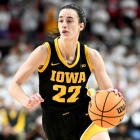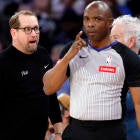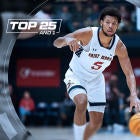As a huge advocate of the predictive powers of the NFL combine, it's rare that I'll all but completely dismiss a poor showing from a prospect in Indianapolis. But the combine isn't the be-all, end-all of pre-draft evaluation of course, and some combine performances don't matter as much as others.
Here are the five prospects who had varying degrees of "bad" combines that shouldn't see their draft stock impacted.
A.J. Epenesa, EDGE/DL, Iowa
Many thought Chase Young would measure in close to the size of Myles Garrett, but it was actually Epenesa who, at 6-foot-5 and 275 pounds, tipped the scales with a nearly identical physical profile to the 2017 No. 1 overall pick.
Then Epenesa ran 5.01 in the 40, a far cry from Garrett's 4.64, but no one on Earth expected Epenesa to test remotely close to the Browns star edge rusher, and, across the board, he didn't.
His 7.34 in three cone is moderately slow -- even given his massive size -- and places him in the 30th percentile among all edge rushers at the combine the past 21 years, per MockDraftable.com. However, Epenesa is more of a defensive end/defensive tackle hybrid than a pure, outside speed rusher. If you move Epenesa's position to "interior defensive line," where he played on just under 12% of his snaps in 2019 per Pro Football Focus and very well could play at a higher rate in the NFL -- Epenesa's three-cone is in the 83rd percentile.
His 117-inch broad jump is in the 62nd percentile among edge rushers yet the 97th among interior defensive linemen. As a power player with the size to legitimately be a versatile trench player who boasts a nice arsenal of pass-rushing moves, Epenesa's slow, non-twitchy combine should not really change how we view him.
Jalen Reagor, WR, TCU
Reagor is a candidate for strangest performance at the 2020 combine. He weighed in at just under 5-foot-11 and 206 pounds, with a chiseled frame. Then, despite hype he could run in the 4.2s or 4.3s, he ran 4.47. After that, we saw his bonkers 42-inch vertical and 138-inch broad jump -- which tied for the second-highest and third-furthest measurements respectively at the receiver spot.
Later, Reagor's 7.31 in the 3-cone was posted. What the? His jumps were in the 97th and 98th percentiles at his position over the past 21 years. His 3-cone -- fifth percentile.
At times on film, Reagor is incredibly slippery, but his explosive is apparent on basically every snap. While his three-cone time doesn't match with the change-of-direction ability on film, Reagor did test like a rather explosive athlete, and the team that picks him will be doing so because of how well he can stretch the field and hit big plays after the catch on short throws catches thanks to his burst and long speed.
It would not surprise me if he's still selected in the first round, because most teams will realize that he likely bulked up to fill out his frame for the combine, which sapped some of the twitch and overall speed.
Jonah Jackson, G, Ohio State
Jackson isn't regarded close to the same as Epenesa or Reagor, so he's a different type of pick for this article. His 2019 film at Ohio State -- after transferring from Rutgers of all places -- is truly, outstandingly boring. And boring is good for offensive linemen.
He plays much higher than most guards and doesn't have the squatty, fire hydrant of a frame we typically envision at the position. Jackson thrives thanks to awesome balance, a sturdy anchor, and two vice grips for hands. His 40-yard dash of 5.23 placed him in the 54th percentile historically among interior offensive linemen, and his 7.83 3-cone equates to the 49th percentile at the position.
But those who like Jackson as a prospect -- like me -- weren't ready to bury Jackson if he didn't rock in Indianapolis. He won't be for every team, and that's fine. He's a lower-level athlete for the guard spot with tremendous fundamentals who overachieved in Columbus and has the technique to do so in the NFL.
Zack Moss, RB, Utah
Moss ran 4.63 in the 40, a time that didn't excite anyone, but with proper context and a firm understanding of why he's considered one of the best prospects at his position in this class, the slow figure in the most famed event at the combine essentially doesn't matter.
The Utah stud measured in at an impossibly compact 5-9 and 223 pounds, which should've foreshadowed a slower time in the 40. And while watching Moss produce at a high level over the past three seasons at Utah, it was obvious he flourished thanks to phenomenal contact balance, stellar lateral cuts, and pure power through tacklers, not his speed.
His 33-inch vertical placed in the 30th percentile historically at the running back spot, yet Moss is a rare back who doesn't even rely on initial explosion -- much less long speed -- to creatively accumulate yardage.
Geno Stone, S, Iowa
Stone is a super-instinctive safety with some zone coverage ability when filling in at slot corner. He's better cycling down into the robber role at the intermediate level than ranging from the deep middle. Therefore, his 4.62 time at just over 5-10 and 2017 pounds is fine.
Like many Iowa secondary members over the years, Stone plays faster than his timed speed thanks to lightning-quick play/route recognition skills honed during his time with Kirk Ferentz. He also shows a strong willingness to fly downhill as the last defender in the box, as evidenced by his 70 tackles in 2019.
The team that drafts stone will love his reliable tackling and ability to diagnose where the football is going a split second before everyone else on the field does.





















